PRE-ROMAN GROUPS
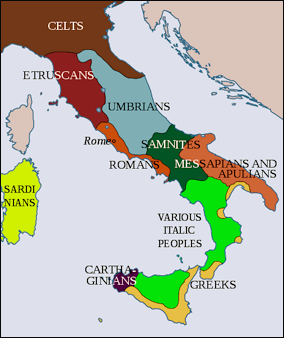
Italy in 400 BCBefore Rome took over what is now Italy the Italian peninsula was dominated by a number of different groups, each with their own language, customs and arts. The first evidence of distinct groups is from around 900 B.C.. Between 800 and 400 B.C. some of these groups became powerful enough to form their own city-states. Their language descended from a mother tongue called Sabellic, whose written form was influenced by the Greek, Latin and Etruscan alphabets. Their art, including figures and faces carved from animals bones, was heavily influenced by Greek art. [Source: Erla Zwingle, National Geographic. January 2005]
The various groups were called Italics. They tended to live in temporary settlements rather than towns; farmed small plots and herded cattle and sheep; traded with foreign merchants such as the Greeks and Phoenicians; fought periodically with neighboring groups; and practiced local religions that revolved around trinities of gods, animal sacrifices and looking for omens in everything from bird flight patterns to sheep entrails.
Bronze Age Roman Village
A few years ago some Bronze Age villages were discovered buried under a Mt. Vesuvius eruption that occurred un 1780 B.C. In 2001, workers digging the foundation for a supermarket just outside the town of Nola found such a site. The first clues to be found were pieces of burnt wood. Archaeologists were called in. Six meters below the surface they found a perfectly preserved Bronze Age village entombed like Pompeii under volcanic ash. The French archaeologist Claude Albore Livadie who wrote the first report about the site called it “a first Pompeii."
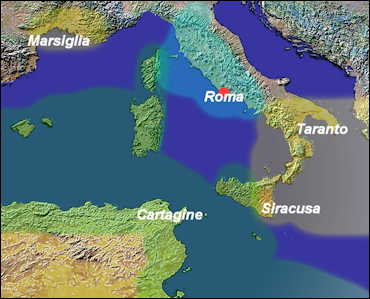
Italy in 509 BCStephen Hall wrote in National Geographic, “Over the next several months, the excavation unearthed three large prehistoric dwellings: horseshoe-shaped huts with clearly demarked entrances, living areas and the equivalent of kitchens. Researchers found dozens of pots, pottery plates, and crude hourglass-shaped canisters that still contained fossilized traces of almonds, flour, grain, acorns, alcove pits, even mushrooms. Simple partitions separated the rooms; on hut had what appeared to be a loft. The tracks of goats sheep, cattle and pigs, as well as their human masters, crisscrossed the yard outside. The skeletons of nine pregnant goats lay in an enclosed area that included an animal pen." [Source: Stephen Hall, National Geographic, September 2007]
Bowing to pressures that time is money, the site was hastily excavated and objects were moved so construction crews could being work again on the supermarket. Backhoes and bulldozers quickly tore up the site... In the end the supermarket was never built and the site sits behind a padlocked gate with as mall signs that reads “Pompeii of Prehistory."
Other Bronze Age villages in the area suffered similar fates. In 2002, a site larger that the one at Nola, with both Copper Age and Bronze Age remains, was uncovered while building a U.S. Navy facility near Gricignano di Aversa. Because the navy facility was deemed essential a quick survey was done and then the site was destroyed. In 2004, thousands of footprints in volcanic ash, found site near the town of Afracola discovered while building a high speed railroad between Rome and Naples, suffered a similar fate.
Different Pre-Roman Group
The largest and most dominate pre-Roman groups, included the Umbrians, who lived north of present-day Perugia and were known as a deeply religious people; the Sabines, whose women were famously raped by followers of Romulus, one of Rome's founders; Samnites, a fighting people that almost defeated the Romans; and the Faliscans, who chose to be absorbed by the Romans rather than fight them.
Other groups included the Marsian people, famed of their snake-handling skills and herbal remedies; and the Piceneians, who lived and the Adriatic and prospered through trade with the Greeks and Phoenicians. Greeks lived in southern Italy and Sicily. Celtic groups such as the Gauls moved into parts of what is now northern Italy.
Samnites
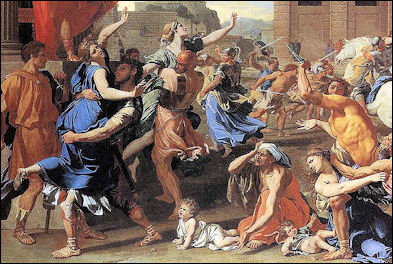
Rape of the Sabine Women The Samnites were rivals of the ancient Romans before the Romans were powerful. Known for their military skill, they were based in the craggy mountains in Abruzzi and Modise and occupied much of southern and central Italy. They were among the last hold outs against the Romans and for a while seemed like the group most likely to dominate Italy. In the 4th century B.C. they controlled Pompeii and other cities. Little is known about them in part because they were one of Rome's fiercest enemies and the Romans wiped out many reference to them.
The Samnites are better seen as a loosely defined alliance than a tribal group. They spoke an Oscan language and were divided into tribal states. They controlled a large area of southern Italy from 600 to 290 B.C., occupying the area around Pompeii around the 6th century B.C.
Although the Samnites are known mainly as warriors they were also skilled artists. In 2004 a 2300-year-old, yellow tuff sarcophagus was founded in at the remote site of Galita del Capitiano near Sarno and Salerno in southern Italy. Believed to belong to a Samnite warrior, it contained marvelous colored frescos, with shades of blue, red and yellow, depicting scenes of victories and triumphant returns with horsemen, bagpipers and unarmed soldiers.
The Samnites worshiped their own pantheon of gods. Their goddess of love was Mephitis. In June 2004, archaeologists from Italy's Basilicata University uncovered remains of a Samnite temple dedicated to Mephitis under a Roman temple dedicated to Venus. The archaeologists found offerings to Mephitis and a basin and terra cotta pipes indicating the site of a ritual bath.
The bath and amulets, Emmanuel Curti, chief archaeologist at the site, told the Washington Post indicate the Samnite practice of ritual prostitutions in which young women rich and poor alike, submitted to sex as a site of passage. “To our post-Victorian minds, the practice seems strange. But we can't look at society through our eyes, Probably the practice became professional at some point. This was, after all, a port city."
Samnite Military
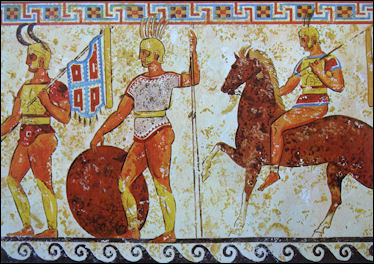
Samnite from a tomb frieze, Nola, 4th century BCSamnite soldiers carried axes, short stabbing swords, spears and shields and wore three'disk corselet armor. They fought in flexible checkerboard formations which made sense for fighting in the mountains and employed guerilla tactics such as lighting quick hit and run attacks that gave their enemies no time to prepare or pursue them. The Samnites were fierce and courageous fighters who often chose to die rather than surrender, leaving thousands dead on the battle field.
The Romans adopted many Samnite tactics. Initially the Romans employed Greek-like phalanx tactics, which were suited more for fighting on plains, against the Samnites in their mountainous homeland and suffered and number of defeats. Later the Romans adopted checkerboard formations---a major military advance for the future rulers of the Western world---and Samnite-style weapons and fared much better.
Samnites Versus Rome
Beginning in 343 B.C. the Samnites fought three wars against the Romans. Taking advantage of a moment when the Samnites were busy fighting the Greeks , the Romans invaded their territory and tried to set up colonies near Naples, but the Samnite struck back. At one point Samnite troops trapped a Roman army in a mountain pass and forced it surrender.
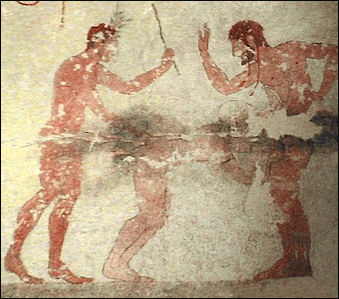
Etruscans The humiliated Roman Senate eventually orchestrated a counterattack. Preparation for renewed war included the construction of the Appian Way, a road that runs south from Rome toward Naples.
The decisive third war between the Samnites and Romans occurred in 295 B.C. when the Romans had taken control of many of the main trade routes in southern Italy and were moving on Samnite territory. The Samnites formed an alliance with Gauls, Etruscans, Umbrians and lesser groups and met the Roman army at Sentinum, near present-day Sassofferrato in the Marches.
The Romans prevailed, in part because they were able to stop the Etruscan and Umbrian troops and prevent them from coming to aid the Samnites. By all accounts the fighting was fierce. Livy recorded 8,700 casualties on the Roman side, the size of Samanite force was not clear. Some scholars have said that around 25,000 people might have died at Sentinum. The Romans were more interested in peace and stability than in occupations and conquest. They signed an alliance with the Samnites that allowed them to rule themselves and maintain autonomy for 200 years.
The Samnites continued to fight after that and were not eliminated as a threat until Roman generals Sulla and Crassus defeated them in 82 B.C. Their reputation remained. Samnite fighting---in which combatants carried large oblong shields, a sword or spear, and was protected by a visored helmet, a greave on the right leg and a protective sleeve on the right arm---was one of the most popular gladiator events.
Influences of Different Pre-Roman Groups

gladiatorsThe Roman custom of giving first and last names came from the Sabines. Gladiator contests evolved out Etruscan funeral rituals. The seven vowel sounds of ancient languages like Umbrian remain alive in Italian even though there are only five vowels in the Latin alphabet. The name “Italy” is derived from an ancient Sabellic word that was originally only used to describe the southern toe of the peninsula.
Several Italic cultures adopted birds such as woodpeckers and ducks as their totems. The Umbrians looked for good and bad omens in the flight patters of birds and their respect towards birds remains alive in avian family names such as Passeri (sparrows), Fagiani (pheasants) and Galli (roosters).
One Italian scholar told National Geographic, “The regionalism that is still so strong today in Italy originally stems from the difference between all these groups. They are lots of cultural roots. Groups that existed in pre-Roman times such as the Sardinians, Corsicans, Ligurians, Venetians, and Umbrians tend to identify themselves by their ancient group first and as Italians second. Italy was fragmented before the Roman Empire and afterwards and did not unify into Italy until the 19th century.
Greek Colonies
The Greeks traded all over the Mediterranean with metal coinage (introduced by the Lydians in Asia Minor before 700 B.C.); colonies were founded around the Mediterranean and Black Sea shores (Cumae in Italy 760 B.C., Massalia in France 600 B.C.)Metropleis (mother cities) founded colonies abroad to provide food and resources for their rising populations. In this way Greek culture was spread to a fairly wide area. ↕
Beginning in the 8th century B.C., the Greeks set up colonies in Sicily and southern Italy that endured for 500 years, and, many historians argue, provided the spark that ignited Greek golden age. The most intensive colonization took place in Italy although outposts were set up as far west as France and Spain and as far east as the Black Sea, where the established cities as Socrates noted like "frogs around a pond." On the European mainland, Greek warriors encountered the Gauls who the Greeks said "knew how to die, barbarians though they were." [Source: Rick Gore, National Geographic, November 1994]
During this period in history the Mediterranean Sea was frontier as challenging to the Greeks as the Atlantic was to 15th century European explorers like Columbus. Why did the Greeks head west? "They were driven in part by curiosity. Real curiosity," a British historian told National Geographic. "They wanted to know what lay on the other side of the sea." They also expanded abroad to get rich and ease tensions at home where rival city-states fought with one another over land and resources. Some Greeks became quite wealthy trading things like Etruscan metals and Black Sea grain.
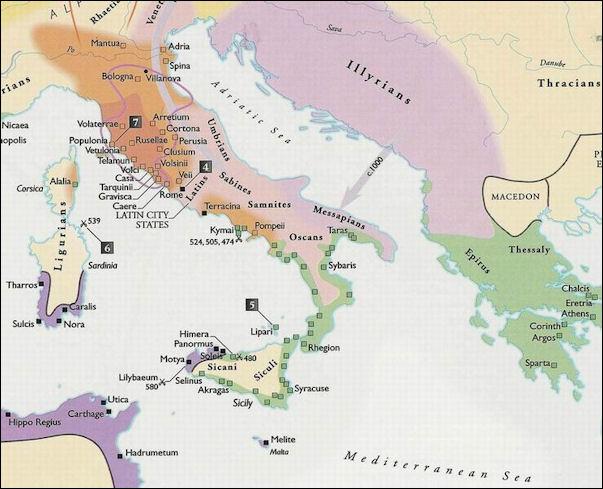
IllyrianWars
Greek Colonies in Italy
The Greeks city states set up a number of colonies in Italy, known then as Magan Graecia (Great Greece), on the site of established town. The first known Greek settlement was established on Pithekoussai, an island off of present-day Naples, in 770 B.C. A few years later colonies were established in Sicily and southern Italy. Many of the early settlers were poor farmers looking for a better life the same way immigrants from Europe came to America in the 19th century to seek their fortune.
The two greatest Greek colonies in Italy were probably Syracuse and Sybaris. "Magna Graecia and Sicily became the Texas of the Greek world," one historian wrote. "Everything was bigger, bolder. It was a grand experiment." Sicily was known as "Sicily the rich" and "the pride of the blossoming earth." In 443 B.C., Pericles---the great leader of Athens--- founded the colony of Thurii on the instep of Italy's boot following advise from the oracle of Delphi. For political reasons he asked other city states to join him and called it a Panhellenic colony.
Two important concepts in the development of mankind---democracy and the construction of cities in a grid pattern---are believed to have evolved in the Greek colonies in Italy. Archimedes and Pythagoras came from Italy and many of the great Greek philosophers that preceded Socrates, were also from the west. The Sicilian city state of Syracuse crushed an invasion from Athens in 413 B.C.
Paestum---south of Salerno in southern Italy---is one of the most impressive set of Greek ruins in the world. The "Temple of Poseidon" looks like a smaller version of the Parthenon (built around the same time) in Athens on steroids. Built about 100 years before is the equally impressive "Basilica." It lacks a roof but it has massive columns that bulge at the bottom. It is long and looks more "elastic." Other ruins include the Temple of Cerese (a 2500-year-old temple later turned into a church), the Roman forum, the gymnasium, the Roman amphitheater, the 2,600-year-old basilica, a museum with paintings and pottery taken from Paestum tombs. Make sure to check out the famous Tomb of the Diver. There is a private beach about a mile and a half from the Paestum.
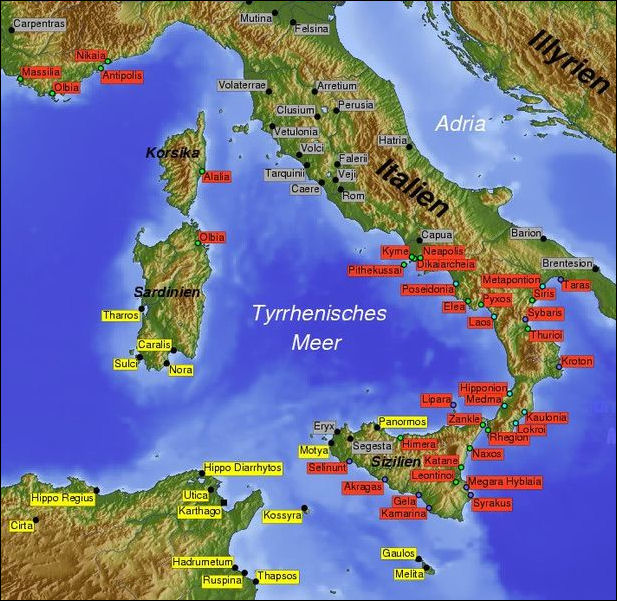
Greek colonies in Italy
On Sicily the Greeks established numerous colonies and left behind monumental temples and theaters which draw large numbers of tourists today. Eastern Sicily is said to have been the inspiration for the myth of Persephone and the seasons. Morgantina (near Armerina) is a Greek city on Sicily that was colonized in the 6th century B.C. and sacked by the Romans in the 3rd century B.C. has produced some of the most spectacular archaeological and looted discoveries made in recant years. Before the Roman invaded, the Greeks buried their wealth. Other Ancient Sites include the Greek ruins of Gela, Agrigento and Selinunte.
Syracuse (in the southeastern corner of Sicily) was almost as powerful as Athens during the golden age of Greece. During Hellenistic times, Syracuse along with Athens and Alexandria were the greatest centers of Greek culture. The city is closely associated with Archimedes. Syracuse's harbor was one of the best in the Mediterranean. An attack by the Sicilian city state against Athens led to the fall of the ancient Greece's most famous city. Although Syracuse invasion was unsuccessful it crushed Athens' sea defenses, allowing the Spartan's to sack Athens a few years later.
Image Sources: Wikimedia Commons, The Louvre, The British Museum
Text Sources: New York Times, Washington Post, Los Angeles Times, Times of London, Yomiuri Shimbun, The Guardian, National Geographic, The New Yorker, Time, Newsweek, Reuters, AP, Lonely Planet Guides, Compton's Encyclopedia and various books and other publications. Most of the information about Greco-Roman science, geography, medicine, time, sculpture and drama was taken from "The Discoverers" [∞] and "The Creators" [μ]" by Daniel Boorstin. Most of the information about Greek everyday life was taken from a book entitled "Greek and Roman Life" by Ian Jenkins from the British Museum [||].
No comments:
Post a Comment